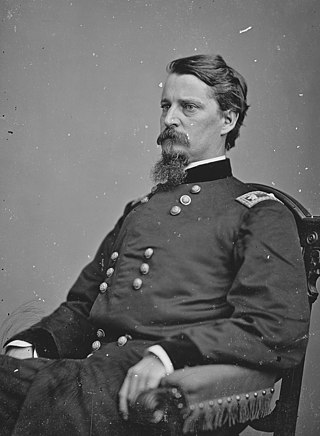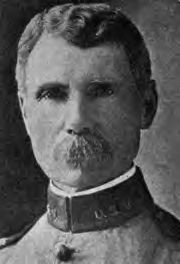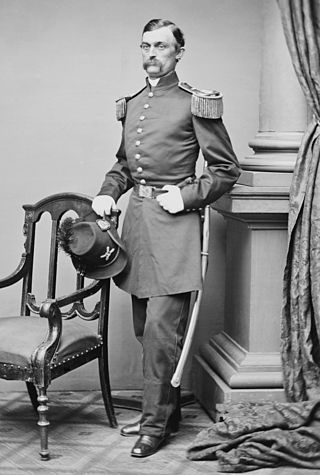
Winfield Scott Hancock was a United States Army officer and the Democratic nominee for President of the United States in 1880. He served with distinction in the Army for four decades, including service in the Mexican–American War and as a Union general in the American Civil War. Known to his Army colleagues as "Hancock the Superb," he was noted in particular for his personal leadership at the Battle of Gettysburg in 1863. His military service continued after the Civil War, as Hancock participated in the military Reconstruction of the South and the U.S.' ethnic cleansing of Native Americans at the Western frontier. This concluded with the Medicine Lodge Treaty. From 1881 to 1885 he was president of the Aztec Club of 1847 for veteran officers of the Mexican-American War.

General of the Army Philip Henry Sheridan was a career United States Army officer and a Union general in the American Civil War. His career was noted for his rapid rise to major general and his close association with General-in-chief Ulysses S. Grant, who transferred Sheridan from command of an infantry division in the Western Theater to lead the Cavalry Corps of the Army of the Potomac in the East. In 1864, he defeated Confederate forces under General Jubal Early in the Shenandoah Valley and his destruction of the economic infrastructure of the Valley, called "The Burning" by residents, was one of the first uses of scorched-earth tactics in the war. In 1865, his cavalry pursued Gen. Robert E. Lee and was instrumental in forcing his surrender at Appomattox Courthouse.
The Reconstruction Acts, or the Military Reconstruction Acts, were four statutes passed during the Reconstruction Era by the 40th United States Congress addressing the requirement for Southern States to be readmitted to the Union. The actual title of the initial legislation was "An act to provide for the more efficient government of the Rebel States" and was passed on March 4, 1867. Fulfillment of the requirements of the Acts was necessary for the former Confederate States to be readmitted to the Union from military and Federal control imposed during and after the American Civil War. The Acts excluded Tennessee, which had already ratified the 14th Amendment and had been readmitted to the Union on July 24, 1866.

The Second Military District of the U.S. Army was one of five temporary administrative units of the U.S. War Department that existed in the American South. The district was stipulated by the Reconstruction Acts during the Reconstruction period following the American Civil War. It included the territories of North and South Carolina, and acted as the de facto military government of those states while a new civilian government was being re-established. It was headquartered in Charleston, South Carolina. Originally commanded by Major General Daniel Sickles, after his removal by President Andrew Johnson on August 26, 1867, Brigadier General Edward Canby took over command until both states were readmitted in July 1868.

Wager Swayne was a Union Army colonel during the American Civil War and was appointed as the last major general of volunteers of the Union Army. Swayne received America's highest military decoration the Medal of Honor for his actions at the Second Battle of Corinth. He also was effectively the military governor of Alabama from March 2, 1867 to July 14, 1868 after the passage of the first Reconstruction Act by the U.S. Congress until Alabama was readmitted to the Union. Robert M. Patton remained the nominal governor during this period but as the local army commander, Swayne controlled the State government. During the Reconstruction era, Swayne oversaw the Freedmen's Bureau in Alabama and helped establish schools for African Americans in the state. He was the first person born after Alabama statehood, to govern the state.

Gouverneur Kemble Warren was an American civil engineer and United States Army general during the American Civil War. He is best remembered for arranging the last-minute defense of Little Round Top during the Battle of Gettysburg and is often referred to as the "Hero of Little Round Top". His subsequent service as a corps commander and his remaining military career were ruined during the Battle of Five Forks, when he was relieved of command of the V Corps by Philip Sheridan, who claimed that Warren had moved too slowly. A post-war court of inquiry found that Sheridan's relief of Warren was unjustified.

The Third Military District of the U.S. Army was one of five temporary administrative units of the U.S. War Department that existed in the American South. The district was stipulated by the Reconstruction Acts during the Reconstruction period following the American Civil War. It comprised Georgia, Florida and Alabama and was headquartered in Atlanta.

Theodore Schwan was a Union Army officer during the American Civil War who received the Medal of Honor for his actions at the Battle of Peebles' Farm. He also served with distinction during the Spanish–American and Philippine–American Wars.

The First Military District of the U.S. Army was one of five temporary administrative units of the U.S. War Department that existed in the American South. The district was stipulated by the Reconstruction Acts during the Reconstruction period following the American Civil War. It only included Virginia, and was the smallest of the five military districts in terms of size. The district was successively commanded by Brigadier General John Schofield (1867–1868), Colonel George Stoneman (1868–1869) and Brigadier General Edward Canby (1869–1870).

The Fourth Military District of the U.S. Army was one of five temporary administrative units of the U.S. War Department that existed in the American South. The district was stipulated by the Reconstruction Acts during the Reconstruction period following the American Civil War. It included the occupation troops in the states of Arkansas and Mississippi. At various times, the district was commanded by generals Edward Ord, Alvan Cullem Gillem, and Adelbert Ames.

Charles Griffin was a career officer in the United States Army and a Union general in the American Civil War. He rose to command a corps in the Army of the Potomac and fought in many of the key campaigns in the Eastern Theater.
The Department of the Missouri was a command echelon of the United States Army in the 19th century and a sub division of the Military Division of the Missouri that functioned through the Indian Wars.

The Commonwealth of Massachusetts played a significant role in national events prior to and during the American Civil War (1861–1865). Massachusetts dominated the early antislavery movement during the 1830s, motivating activists across the nation. This, in turn, increased sectionalism in the North and South, one of the factors that led to the war. Politicians from Massachusetts, echoing the views of social activists, further increased national tensions. The state was dominated by the Republican Party and was also home to many Radical Republican leaders who promoted harsh treatment of slave owners and, later, the former civilian leaders of the Confederate States of America and the military officers in the Confederate States Army.

William Henry Forwood was a surgeon from Brandywine Hundred, Delaware, who served in the Union Army during the American Civil War and eventually as Surgeon General of the United States Army from June 8, 1902 until September 7, 1902.

The 13th Infantry Regiment is a United States Army infantry regiment whose battalions are currently tasked as basic training battalions.

Louis Henry Carpenter was a United States Army brigadier general and a recipient of the Medal of Honor for his actions in the American Indian Wars.

Henry Martyn Lazelle was a career officer in the United States Army. In addition to serving during the American Civil War and Indian Wars, he was Commandant of Cadets at the United States Military Academy from 1879 to 1882.
The 116th United States Colored Infantry was an infantry regiment of the United States Colored Troops serving in the Union Army organization made up of African-American troops and white officers during the American Civil War.

Clarence Edmund Bennett (1833–1902), usually referred to as Clarence E. Bennett, a graduate of West Point, a career American Army officer who saw duty almost exclusively in Western frontier assignments, served in the American Civil War in California, New Mexico and Arizona Territories and later in Reconstruction occupation forces and frontier duty during the later Indian Wars.

Following the end of the American Civil War, five Reconstruction Military Districts of the U.S. Army were established as temporary administrative units of the U.S. War Department in the American South. The districts were stipulated by the Reconstruction Acts during the Reconstruction period following the American Civil War.













